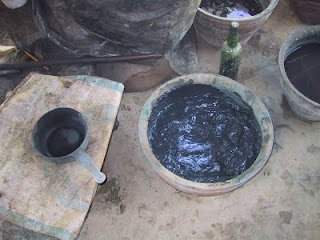An odd series of coincidences led me here. First of all I was writing an article on the history of dyes for a book about inventions. Quite separately about the same time, a friend lent me a copy of Simon Garfield’s popular history of the colour mauve. And then a day or two later someone got in touch with me via this blog: it turned out that our great great grandmothers were sisters, Emma and Mary Anne Gurney. Emma married William Augustus Salter, a young Baptist minister – he was ordained in his first church less than a fortnight before their wedding. Her older sister Mary Anne married William Kingsbury Jameson, son and heir of William Jameson senior, an indigo merchant in the City of London.
Now that’s a profession you don’t hear much of these days! But when WKJ died in 1864, he left an estate of nearly £70,000, an indication of the economic importance of the global indigo trade at the time. Indigo the colour comes from indigo the plant, Indigofera tinctoria, which for thousands of years has been soaked in water and beaten to a pulp with bamboo sticks to produce the richest of all blues for painting and dyeing. For ease of storage, transport and trade the liquid is heated until it dries to a block of deep blue paste.
Indigo paste
The plant comes originally from the Indian sub-continent (which gave indigo its name), and contains in stronger measure the same chemical component as woad, the plant which was the traditional western European source of the colour blue. Indigo came to Europe when a Portuguese trading ship returned from the East with a cargo. From Portugal a consignment found its way in the 1570s to the docks of London.
Some European states put up protectionist resistance to indigo, which they saw as a threat to their native woad industry. But in time Britain saw the advantages of a valuable crop grown in the colonies of its expanding empire. In 1770 it was importing nearly a million pounds worth not only from Bengal but also from its plantations in South Carolina. France and Portugal also introduced the plant to their colonies in the Americas from Brazil to Mississippi.
Navy blue frock coat of a British admiral, c1805
when Britannia ruled the waves
It is the sheer depth of colour which made indigo such a precious commodity. And it became so valuable that merchants dealt in it as a currency of credit. As a dye, its popularity increased as the British textile industry expanded towards the end of the eighteenth century. The dark satanic cotton mills of northern England boosted demand for the deep exotic blue, in everything from Union Jacks to Navy Blue uniforms. A whole new class emerged in Britain, the blue-collar workers. In the age of Empire, Great Britain wore blue.
Britain, and merchants like the Jamesons, dominated the world indigo market in the first half of the nineteenth century. William Jameson senior was originally in partnership with a German entrepreneur called Charles Aders. But in 1832, the year William junior and Mary Anne got married, the firm of Jameson & Aders was restructured as William Jameson & Son. I imagine it was a wedding gift; but it may also have been that Aders was glad to be bought out. He was a passionate collector of early Flemish art who might have welcomed an injection of cash to pay for his acquisitions. As it was, Aders was declared bankrupt with a year or two of parting company with Jameson.
William Henry Perkin
invented mauveine, the first synthetic dye
Dealing in indigo was a license to print money, to judge from the value of WKJ's estate. What could possibly go wrong? Why aren’t the Jamesons indigo millionaires to this day? In 1856, an English chemist called William Henry Perkin accidentally invented the world’s first synthetic dye – he had been trying to synthesise quinine, a treatment for malaria. The new colour was mauve, the first of a wave of unimagined shades which excited the fickle world of fashion. Why be boring blue any more? Prices of traditional natural dyestuffs almost halved over the next five years, as colourful chemical alternatives were found. Although it was more than thirty years before a true synthetic version of indigo was found, cheaper approximations replaced it in many uses.
Karl Heumann
produced a viable synthetic indigo dye
Never again would indigo be the blue gold it had been for William Kingsbury Jameson and his father. WKJ’s son William Gurney Jameson did, it’s true, follow his father into the business. But trade tapered off, and in 1890 the German chemist Karl Heumann finally produced a viable synthetic indigo. By then WGJ had shut up shop. In 1881 he described himself merely as a general merchant; 1891 found him “living on his own means” at a boarding house in Bristol, and he died unmarried, the end of the line, the following year. Within twenty years of Heumann's breakthrough the indigo industry was all but extinct.
Thanks to Ian Mackintosh, archivist of the Worshipful Company of Dyers, for help with background information about the indigo trade; to descendents of WKJ, who have shared their family knowledge with me; to Simon Garfield’s history of synthetic dyes, “Mauve;” and to Kate Long, whose definitive online thesis on indigo is a damn good read!









No comments:
Post a Comment